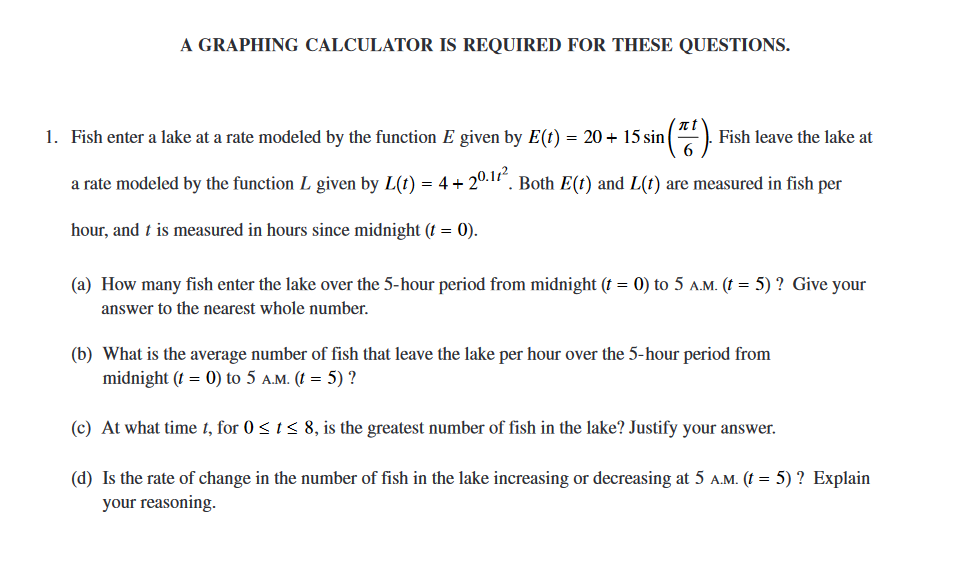A GRAPHING CALCULATOR IS REQUIRED FOR THESE QUESTIONS. 1. Fish enter a lake at a rate modeled by the function E given by E(t) = 20 + 15 sin| ), Fish leave the lake at a rate modeled by the function L given by L(t) = 4+ 20.1 . Both E(t) and L(t) are measured in fish per hour, and t is measured in hours since midnight († = 0). (a) How many fish enter the lake over the 5-hour period from midnight (t = 0) to 5 a.M. (t = 5) ? Give your answer to the nearest whole number. (b) What is the average number of fish that leave the lake per hour over the 5-hour period from midnight (t = 0) to 5 a.M. (! = 5) ? (c) At what time 1, for 0 < 1 < 8, is the greatest number of fish in the lake? Justify your answer. (d) Is the rate of change in the number of fish in the lake increasing or decreasing at 5 A.M. (t = 5) ? Explain your reasoning.
A GRAPHING CALCULATOR IS REQUIRED FOR THESE QUESTIONS. 1. Fish enter a lake at a rate modeled by the function E given by E(t) = 20 + 15 sin| ), Fish leave the lake at a rate modeled by the function L given by L(t) = 4+ 20.1 . Both E(t) and L(t) are measured in fish per hour, and t is measured in hours since midnight († = 0). (a) How many fish enter the lake over the 5-hour period from midnight (t = 0) to 5 a.M. (t = 5) ? Give your answer to the nearest whole number. (b) What is the average number of fish that leave the lake per hour over the 5-hour period from midnight (t = 0) to 5 a.M. (! = 5) ? (c) At what time 1, for 0 < 1 < 8, is the greatest number of fish in the lake? Justify your answer. (d) Is the rate of change in the number of fish in the lake increasing or decreasing at 5 A.M. (t = 5) ? Explain your reasoning.
Functions and Change: A Modeling Approach to College Algebra (MindTap Course List)
6th Edition
ISBN:9781337111348
Author:Bruce Crauder, Benny Evans, Alan Noell
Publisher:Bruce Crauder, Benny Evans, Alan Noell
Chapter2: Graphical And Tabular Analysis
Section2.1: Tables And Trends
Problem 1TU: If a coffee filter is dropped, its velocity after t seconds is given by v(t)=4(10.0003t) feet per...
Related questions
Question
Fish enter a lake at a rate modeled by the function E

Transcribed Image Text:A GRAPHING CALCULATOR IS REQUIRED FOR THESE QUESTIONS.
1. Fish enter a lake at a rate modeled by the function E given by E(t) = 20 + 15 sin|
), Fish leave the lake at
a rate modeled by the function L given by L(t) = 4+ 20.1 . Both E(t) and L(t) are measured in fish per
hour, and t is measured in hours since midnight († = 0).
(a) How many fish enter the lake over the 5-hour period from midnight (t = 0) to 5 a.M. (t = 5) ? Give your
answer to the nearest whole number.
(b) What is the average number of fish that leave the lake per hour over the 5-hour period from
midnight (t = 0) to 5 a.M. (! = 5) ?
(c) At what time 1, for 0 < 1 < 8, is the greatest number of fish in the lake? Justify your answer.
(d) Is the rate of change in the number of fish in the lake increasing or decreasing at 5 A.M. (t = 5) ? Explain
your reasoning.
Expert Solution
This question has been solved!
Explore an expertly crafted, step-by-step solution for a thorough understanding of key concepts.
This is a popular solution!
Trending now
This is a popular solution!
Step by step
Solved in 5 steps with 5 images

Knowledge Booster
Learn more about
Need a deep-dive on the concept behind this application? Look no further. Learn more about this topic, calculus and related others by exploring similar questions and additional content below.Recommended textbooks for you

Functions and Change: A Modeling Approach to Coll…
Algebra
ISBN:
9781337111348
Author:
Bruce Crauder, Benny Evans, Alan Noell
Publisher:
Cengage Learning

Functions and Change: A Modeling Approach to Coll…
Algebra
ISBN:
9781337111348
Author:
Bruce Crauder, Benny Evans, Alan Noell
Publisher:
Cengage Learning